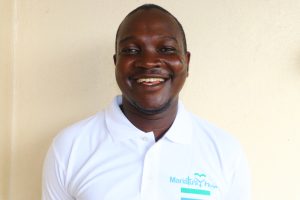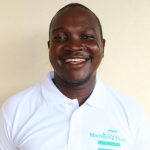In the Upper Thonkoya Community, the 155 residents have access to a distant well, but the long walk to get there and the overcrowding that happens makes it difficult to rely on. With no other safe options, community members use a swamp that leaves much to be desired.

The swamp.
"The long walking distance makes the water users become tired. There is always quarreling and fighting at the alternate water source, especially when there is a breakdown with the main source," shared Field Officer Alimamy Lamin.
"The distance to the current water source worries me about my safety. For example, the alternate water source is surrounded by vegetables, and the gardeners always apply fertilizer to the soil, which may contaminate the water from the alternate source. This may impose a health hazard in our system, and this worries me about the safety of the alternate water source," Fatmata, 15, shared as she expressed her fears.

Fatmata collecting water.
Fatmata has to walk long distances to her school, as there isn't one in her community. She also has to walk to collect water. She spends so much time trying to meet her and her family's water needs that getting an education is incredibly challenging.

"I always feel unhappy when I am asked to fetch water due to the distance to the water source," Fatmata shared.
"My time at school is affected due to the shortage of water in the community. I need water before going to school, and that will take some time before getting the water I need. Before getting the quantity of water I needed, I was already late to go to school, and the school was out of my community. That makes me perform poorly in my academic activities. So, therefore, fetching water impacts my time at school and leads to poor exam scores."
Installing a well in the Upper Thonkoya Community will ease some of the strains that Fatmata faces daily. She can pursue her dreams without having to make the tedious journey to the distant water points.

Fatmata making the journey.
"My future plans are to work for my community people and make sure they all have access to safe drinking water," she concluded.
Steps Toward a Solution
Our technical experts worked with the local community to identify the most effective solution to their water crisis. They decided to drill a borehole well, construct a platform for the well, and attach a hand pump.
Well
Abundant water often lies just beneath our feet. Aquifers—natural underground rivers—flow through layers of sediment and rock, offering a constant supply of safe water. A borehole well is drilled deep into the earth to access this naturally filtered and protected water. We penetrate meters, sometimes even hundreds of meters, of soil, silt, rock, and more to reach the water underground. Once found, we construct a platform for the well and attach a hand pump. The community gains a safe, enclosed water source capable of providing approximately five gallons of water per minute. Learn more here!
Community Education & Ownership
Hygiene and sanitation training are integral to our water projects. Training is tailored to each community's specific needs and includes key topics such as proper water handling, improved hygiene practices, disease transmission prevention, and care of the new water point. Safe water and improved hygiene habits foster a healthier future for everyone in the community. Encouraged and supported by the guidance of our team, a water user committee representative of the community's diverse members assumes responsibility for maintaining the water point, often gathering fees to ensure its upkeep.

 Borehole Well and Hand Pump
Borehole Well and Hand Pump
 Rehabilitation Project
Rehabilitation Project
















